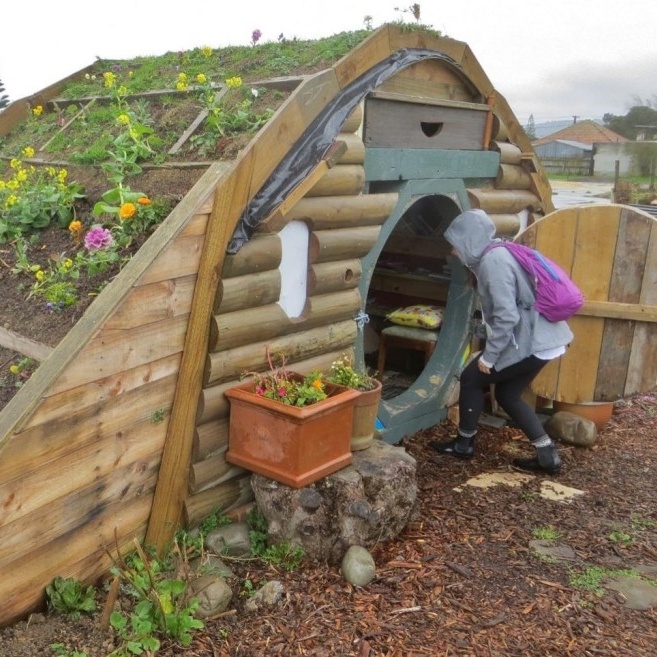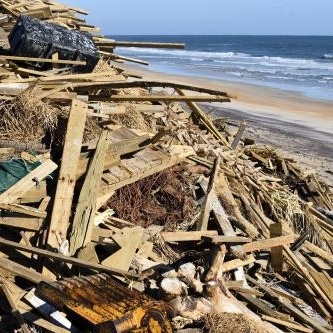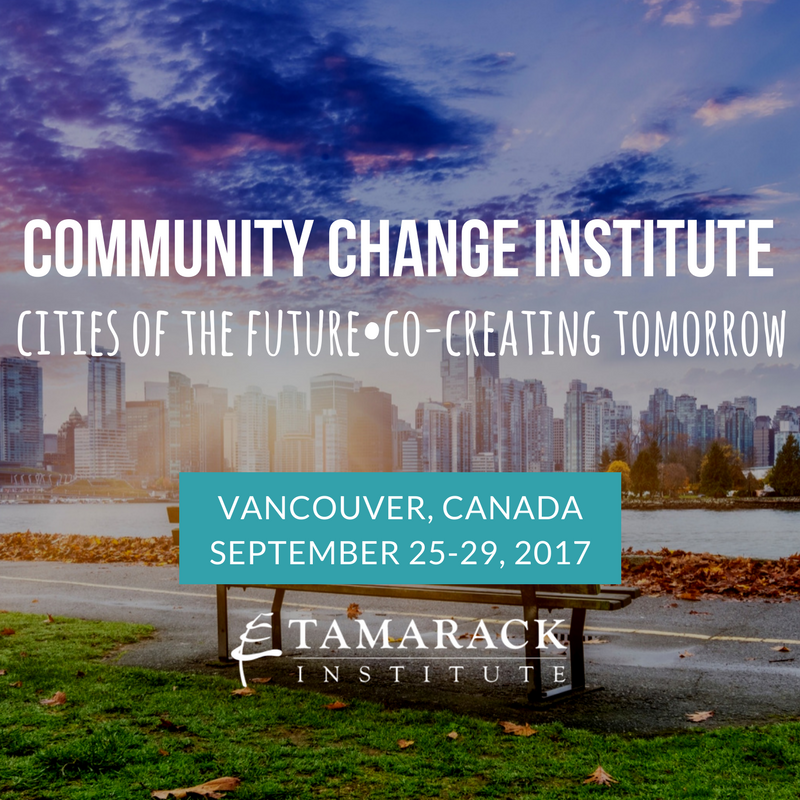Tamarack Institute | Summer Edition, 2017
In this Issue:
- Developing Collective Impact Strategies
- Fostering Connection, Sharing Stories, and Creating Community
- Civic Leadership and Community-Based Leadership Programs
- Engaging Change through Whole-self and Whole-systems Exploration
- Canada150
- Berrett-Koehler Birthday Book Sale July 10–16!
- The Latest from the Field
- Upcoming Events You Won't Want to Miss
Developing Collective Impact Strategies 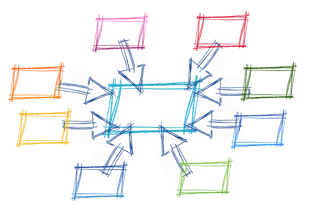
BY: MARK HOLMGREN
Those of us engaged in the work of Collective Impact (CI) know that, having this clear and comprehensive framework, is an essential roadmap for effectively tackling complex issues. However, applying the CI Framework to your own issue and developing wide consensus around a plan of action can still be challenging work. If you find yourself nodding in agreement to the previous statement, then you will want to be sure to read my latest paper, Developing Collective Impact Strategies in which I share tools and approaches designed to help with the development of collective impact strategies.
This resource is meant to serve as a guide for you and your colleagues as well as to stir your thinking. For example, the first task of any collective impact initiative is to define its common agenda. In reality, this is hardly a linear process. Rather bringing a diversity of stakeholders, from different sectors, together is often messy work whose clarity only emerges after several iterations. Being intentional during this dialogue phase of making effective use of both divergent to convergent thinking is just one of the ways highlighted to encourage groups to move towards clarity regarding their common agenda and shared aspiration.
Agreement on a common agenda is an important milestone for any Collective Impact Initiative. However it is only a first step. Next the group must agree upon a set of strategies for action that connect the 5 conditions of Collective Impact, and then identify shared measures related to them. At this stage of development, the use of clear strategy criteria can bring clarity to this process and ensure that the overall action plan for your CI Initiative is comprehensive.
The development of effective strategies within your overall CI Action Plan is another critical success factor for a robust and effective Collective Impact effort. My definition of an “effective strategy” is: An effective strategy identifies a solution and a goal, how it will be pursued by whom, who is being targeted, and a frame that identifies both scope and boundaries.” In my experience, the details of how to bring a strategy to life become easier to grasp if the overarching strategy statement covers necessary ground at a high level.
In outlining this approach to strategy development, my hope is that it can help you in the development of your own Collective Impact effort. Overall, my advice to you is to think of Collective Impact, like all methods or models, as a framework, not a prescription. Make it your own. Draw from your own experience to find ways that are alive for you and your colleagues. And, remembering that Collective Impact is an evolving field of practice, I welcome any comments or ideas on how to improve upon what I have offered above, I am keen to hear them.
Learn More
- Read Developing Collective Impact Strategies by Mark Holmgren
- Share your ideas and feedback on this paper with Mark Holmgren via email: mark@tamarackcommunity.ca
- Find more resources on Collective Impact at tamarackcommunity.ca
- Join Mark and the Tamarack Team at the Community Change Institute - Cities of the Future: Co-Creating Tomorrow – Sept. 25-29, 2017 in Vancouver, BC
Share this article:
Fostering Connection, Sharing Stories, and Creating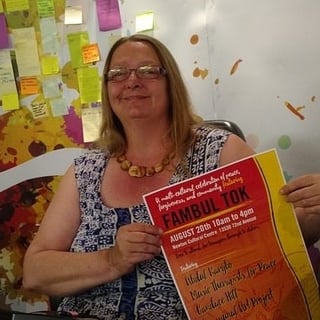 Community
Community
BY: SYLVIA CHEUY
“People become the stories they hear and the stories they tell.”
- Elie Wiesel
Over the past several weeks I have had the opportunity to learn, and be inspired by, examples that illustrate how powerful the simple act of engaging in heart-felt conversation and listening can be when it is is rooted in compassion and curiosity.
At our recent Neighbourhoods ♥ the Heart of Community | Les Quartiers ♥ Le Cœur de la Communauté Learning Event in Montréal, I had the pleasure of meeting Katheren Szabo, a 55-year-old local community organizer from Surrey B.C. Katheren, who is physically disabled and lives on a fixed income, has been described as “the heart of Newton” and recognized as a driving force behind a renaissance that is now unfolding in the poor and challenged neighbourhood where she lives. This includes: being a founder of Friends of the Grove – a vibrant community collective that uses music, art and playfulness to bring peace and harmony to Newton; helping to form the Cedar Bark Poets a group of local residents that publishes a monthly anthology of poems; and, supporting the establishment of a free food garden known as The Plot.
Many of the ideas that Katheren has for community action come from what she learns while holding a 60-day vigil each year where she sits for two hours a day in a local park and just listen to residents. These vigils have confirmed that there is a great deal of loneliness and despair in Katheren’s neighbourhood. As she listens, Katheren draws from her own life experiences to offer her neighbours acknowledgement and compassion: something that many have never experienced before. Reflecting on her experience as “the community listener”, Katheren shared that, “Over the years that I have held my community vigil, people have shared stories with me of how they have been hurt by others, or wish for forgiveness for the pain that they know they have caused to others.” In response, Katheren’s latest dream is to host a ‘Fambul Toks’ peace and reconciliation process for Newton residents on August 20th, 2017.
Fambul Tok, or Family talk in Krio (An English-based slang from Sierra Leone), is a ceremony where victims and perpetuators of Sierra Leone’s 11-year civil war come together face-to-face to discuss what has happened, to heal as a collective and most importantly, to forgive. Katheren explains, “After learning about Sierra Leone’s Fambul Tok process, I got the idea to hold a modified Fambul Tok for my community to offer my wounded neighbours an opportunity to release the pain they have been internalizing and receive the forgiveness they crave. I envision Newton’s Fambul Tok event as creating a Healing Circle where one person stands and says: “I’ve have done something in my past that I was never able to say sorry for.” Then another neighbor who has been previously harmed could stand and say “I have been hurt by someone who never apologized. Thank You. I Forgive You.”
***********************
Libby and Len Traubman recently shared highlights from their “50-year adventure together” with the graduating class of Notre Dame de Namur University in California. Their work together has included starting and co-sponsoring dozens of initiatives to create respectful communication between groups experiencing intense conflict. They began these projects more than two decades ago in their own home with a series of Jewish-Palestinian Living Room Dialogues that continues today. They have worked internationally to foster similar exchanges, including reconciliations between Muslims and Christians in West Africa, as well as inter-racial dialogues in several California cities.
In 1984, in the midst of the “Cold War” between the Soviet Union and America, the Traubmans spent three weeks in Russia listening to the life stories of people there. As Len notes, “We experienced their equal humanity, and realized forever that “an enemy is one whose story we have not heard.” We returned home inspired and alive — not kidnapped, poisoned, or imprisoned as our parents feared. This experience also taught the Traubmans the power of sharing our stories with one another because conflict resolution begins with first knowing the other human being. “Who are you? Tell me your story.”
The Traubmans have produced six films to document the role of dialogue and listening in conflict resolution. Their documentary Dialogue in Nigeria is still used today by African facilitators who use the film’s practices to resolve tribal wars and, to know and de-stigmatize people with disabilities, and include them fully in community life. More recently, following the 2017 post-elections in San Mateo County, the Traubmans hosted CROSSING LINES IN SAN MATEO: Sharing Stories, Creating Community an event which features 115 diverse men and women, ages 18 to 85, experiencing “what many never do in a whole lifetime — being given voices and ears, being heard and hearing, with a new quality of listening-to-learn, listening to everyone.”
In reflecting on their work, the Traubmans then offered this inspiration to the graduates,
“This next epoch of your adult life means less dependency and more initiating; taking less and more giving. But giving what? We’ve illustrated what you already know — what strengthens families and ends war: Everyone has a story that needs, even cries, to be listened to. Unheard and disregarded, very good, loving women, men, and youth can become hopeless, desperate, even violent, even terrorists. This is preventable and curable — by you — if today you can choose to become a great listener. As the first one in the room to listen, you have the power to change the relationship.”
Learn More:
- Read Katheren Szabo’s Blog about hosting the first-ever Fambul-Tok Celebration in Surrey BC
- Download STORIES OF CHANGE: Creating a Culture of Connection in The Citizens’ Century Libby and Len Traubman’s 2017 commencement address at Notre Dame de Namur University
- Listen to CROSSING LINES IN SAN MATEO which shares the stories of 115 diverse residents
- Watch a trailer for Dialogue in Nigeria, a documentary by Libby and Len Traubman
- Learn more about Local Deepening Community Initiatives – A Partnership with Tamarack to host community conversations that strengthen neighbourhoods and reweave their social fabric
Share this article:
Civic Leadership and Community-Based  Leadership Programs
Leadership Programs
BY: CHRIS THOMPSON
Wicked, persistent problems that diminish the quality of life in our communities often frustrate leaders accustomed to achieving change within their own organizations and institutions. While they know that homelessness, blight or hunger cannot be addressed as quickly as the strategic challenges they resolve within their company, hospital or university, they understandably wonder why progress on civic challenges is so elusive. And if these leaders travel or talk with colleagues from across the globe, they may also wonder why some communities make progress on wicked, persistent problems and others don’t.
The key to addressing long-standing challenges within a community is neither wealth, nor wisdom – though those can help. Dollars and ideas are not enough. Leadership is what matters most. A specific type of leadership. In the Stanford Social Innovation Review article The Dawn of Systems Leadership, authors Peter Senge, Hal Hamilton, and John Kania articulate the value of specific leadership capabilities that enable community leaders to build and sustain the conditions for collective action on social issues.
Systems leaders recognize that bringing change within complex civic systems requires different behaviors and skills than does leading within an organization. Organizations have hierarchies, lines of authority, and established processes for achieving change. Those features are less clear (or completely absent) within the complex civic systems that determine the quality of education, public health, food security, safety, and other outcomes in our communities.
The article implicitly asks, “How do we create more and more, effective systems leaders?” I’ve heard the same question asked explicitly at civic tables in many communities and at national think tanks.
One answer should be our community-based leadership programs. (The Association of Leadership Programs is the membership organization for these types of programs and has members across the United States and Canada.)
These programs exist in nearly every large- to medium-size community. They tap organizational leaders from business, nonprofits, government, education, law, and other sectors, and expose them to an intense, months-long curriculum that strengthens their professional network, and their understanding of the opportunities and challenges within their community.
Participants in these programs often emerge eager to “do something.” And some leadership programs make it easier for graduates to take on a “project” together. The programs could be even more effective if they encouraged leaders to focus less on “what” to do, and more on “how” to exercise leadership within the complex civic systems that shape our communities.
These programs could help leaders develop the skills necessary to catalyze systems change (to be systems leaders) by having them participate in role-playing scenarios and other exercises that help them: 1) learn how complex civic systems differ from organizations; 2) understand why those differences require cross-sector collaboration to achieve change; and 3) develop and practice the leadership skills that facilitate effective collaboration.
Based on work done in partnership with Leadership Akron and the Cleveland Leadership Center, I believe community-based leadership programs can help organizational leaders become stronger systems leaders by focusing on strengthening three skills:
- Inquiry: Participants practice asking compelling questions that help them and others think differently about the challenges and opportunities within the system. Practicing inquiry can be risky business, but it also is the best way to catalyze new approaches to addressing persistent problems. Marcy Levy Shankman, formerly with the Cleveland Leadership Center and now a leadership coach and strategist to the CEO of the Cleveland Metropolitan School District, helped us develop three distinct kinds of compelling questions that systems leaders need to learn to ask:
- Foundational questions help participants understand the scope of the system where they want to catalyze change. Such questions clarify why the system is performing as it is, and where there are opportunities for improvement.
- Aspirational questions help players explore what is possible if freed from the constraints of how the system is operating today.
- Procedural questions help define conditions that need to exist, including who needs to be engaged, before stakeholders are willing to pursue change together.
- Assessing Context: Leaders need to understand the motivations and priorities of other stakeholders that make up the system. Are stakeholders stuck in “turf protection mode” or are they committed to disrupting the status quo? We use scenarios that engage leaders in role-playing to help them practice surfacing the motivations and priorities of other stakeholders, and to assess whether collaboration is possible.
- Building Trust: Cross-sector collaborations move at the speed of trust. Trust has no memory so leaders need to build it every day, and broken trust can last forever unless leaders work to rebuild it. Building trust requires leaders to understand the basic elements of trust, and how to behave in ways that reinforce those elements. Peer-to-peer learning exercises, such as the Trust Equation, help participants experience how others assess trustworthiness, and increase their understanding of how to act in ways that build trust.
As Senge, Hamilton, and Kania emphasize, systems leadership requires a great deal of rigor and practice. Unfortunately, most civic leaders presently are practicing in the civic arena – often in the heat of a crisis – rather than on a practice court. We know what would happen if LeBron James (or any other athlete) failed to sharpen their skills before entering the arena. We shouldn’t expect our leaders to be effective if they haven’t practiced, either. Community-based leadership programs can provide a safe place for emerging systems leaders to practice the skills that are required to catalyze enduring, positive change in our communities.
Learn More:
- Learn more about Chris Thompson and visit his website, Civic Collaboration Consultants
- Read Chris’s recent blog, Collaboration, Not Coblaboration
- Download a copy of The Collaboration Handbook written by Chris Thompson
- Find more resources on Collaborative Leadership at tamarackcommunity.ca
Share this article:
Engaging Change through Whole-self and Whole-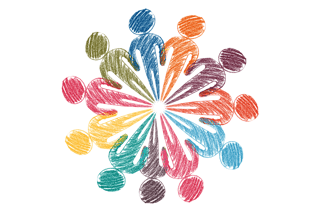 systems Exploration
systems Exploration
BY: DIANA CLAIRE DOUGLAS
After attending Tamarack's Collective Impact 3.0 conference in May, as a systemic facilitator, coach and consultant, I began to wonder if there might be something I could offer that could be integrated into the processes already used by Tamarack? My answer is yes! I facilitate a process, tool and methodology called Systemic Constellation Work (SCW)1 that offers a way for individuals, organizations, institutions, communities, and cities to experience and engage collectively in systems change.
As a participant and "newbie" to Collective Impact, Tamarack Institute and the Ontario Trillium Foundation (OTF), I appreciated learning about the different aspects of the CI framework, making new connections, and participating in small group dialogues. As a facilitator, host and participant of conferences, workshops and retreats for 35 years, I enjoyed feeding into this collective field. Here's what enlivens me the most:
- It's time for systemic change;
- Lifelong learning is a core value;
- Imagination and creativity are vital for transformation – including new ways of thinking – as experienced with the introduction to Human-Centred Design; and,
- There is an openness to change in this field. OTF (the funders), Tamarack (the manifestors) and CI (the process) are each contributors to the process of making systemic change.
So, what is Systemic Constellation Work (SCW)? It is a systemic approach to design, inquiry, research, mapping, testing, seeing the whole system, leadership development and community building. For example, one of the tools is 4D mapping: the system is mapped in 3D space (a room, a tabletop, on the internet) through the use of markers (people, paper, foam mats). This 3D map becomes a 4D living dimensional map of the system as time, space, direction, movement and (often hidden) dynamics are expressed. The purpose of SCW is to inform the members of the system by showing the relationship between and amongst the elements of the system as well as the system as a whole. The 4D, co-created map shows the system as it is, making it easier to envision possible next steps or resolutions. For example, Integral City's Community of Practice has discovered the power of SCW to make visible the invisible dynamics alive in the city. This enables practitioners to align strategies with the histories, cultures, relationships and intentions to release energies leading to impactful resolutions.
SCW involves people bringing their whole selves — gut, heart, spirit as well as intellect — to participate in learning together. It involves tapping into the Knowing Field, which invites participants to engage with not-knowing as well as knowing, and trust that we can access wisdom, intelligence and information way beyond what our intellects allow. It allows us to access the emerging future as well as the emerging past.
In sharing a desire to offer ways to create healthy, dynamic communities within rapidly changing complex environments, Systemic Constellation Work could add value to Tamarack’s community development programs, projects and purposes. Based on our experiences with colleagues such as Integral City Meshworks, here are some examples of what Systemic Constellation Work offers change-makers
- Engage the issues and questions they have about the theme, their community, their city with their whole selves;
- Together be able to see their system as a whole system;
- Access the hidden dynamics that may be blocking a pathway forward; and,
- Co-design and co-create processes and products that align with visions and values and test the prototypes.
Knowing Field Designs would like to acknowledge Kara Stonehouse and Tucker House in Ottawa for introducing us to Collective Impact and we look forward to sharing Systemic Constellation Work with the members of Tamarack’s learning community.
Learn More:
- Contact Diana Claire Douglas via email at: dianaclairedouglas@bell.net;
- Visit Diana’s website, Knowing Field Designs: Aligning Human Systems with Life here
- View Integral City’s Report for an example of the process and outcomes of Systemic Constellation Work
- Find other Collective Impact 3.0 resources here
Share this article:
Canada150
BY: PAUL BORN
What a summer it has been. I am currently on a summer break to rest and reflect and am feeling pretty grateful to our board, Liz Weaver (Acting President) and our team for giving me this opportunity. As you can imagine, getting some extended time away can make one optimistic. I am finding it pretty easy to smile these days.
Canada Day at 150 made us all a little bit prouder about this great country we live in. It is brilliant seeing so many happy faces and hearing the words of our leaders and citizens as they reflect on what a great country we are. The many celebrations in communities across the country reminds us how diverse and yet how similar we are.
Here are five things that make me proud about living in Canada. As the son of refugees I am so grateful to be part of this 150 year evolving experiment.
- I live in Waterloo, Ontario and on Canada Day our family, with friends, always go to watch the fireworks. It is a great event that seems to bring our entire community into one place. What brought a special smile to my face this year was the diversity of the people attending. It seemed like people from countries throughout the world were gathering; in fact they were. Canada is a multicultural society and I am pretty sure this is the thing I love most about our country.
- We want to end poverty: our Federal government has made poverty reduction a national priority. We will have a federal strategy very soon.
- Paying a living wage: we have a national movement brewing that will see better jobs for all. I am so proud of living wage cities and most proud of Alberta and Ontario for moving toward a $15 an hour minimum wage. For me this is a dream come true.
- We talk a lot about caring: our Prime Minister Justin Trudeau gave a wonderful speech on Canada Day at the celebrations in Ottawa. He echoed what so many were saying across the country. We need to open our hearts to those in need and work together to build a better Canada.
- We can embrace our mistakes: one of things that made me most proud as we celebrated Canada 150 was the way people openly talked about our country's shameful history with our aboriginal, native, Indigenous, Meti and Inuit people. There were peaceful protests, many front page stories and deliberate attempts to rebrand our celebration. The one I loved the most was in Vancouver where aboriginal leaders and city officals came up with Canada 150 plus. A wonderful expression of hope for the future of our country.
At Tamarack we are also thrilled to be celebrating our 15th year. In a very small way, like you, we are part of what is making Canada an amazing place to live.
I would love to hear your top five prouds about Canada. Make my summer and send me an email paul@tamarackcommunity.ca I would love to hear from you.
Much joy and Happy Canada 150 plus to you.
Learn More:
- Read more blogs by Paul
- Watch Prime Minister Justin Trudeau's Canada Day speech
- Learn more about Canada 150 plus
Share this article:
Berrett-Koehler Birthday Book Sale July 10–16!
BY: SYLVIA CHEUY
Since it’s release in 2015, Paul Born’s book, Deepening Community: Finding Joy Together in Chaotic Times has become a national best-seller. As growing levels of loneliness and isolation are reported amongst people of all ages across the country, the need to discover new ways to foster connection between neighbours has never been greater.
In celebration of the 25th birthday of the book’s publisher, Berrett-Koehler, for a limited time you can purchase a copy of Paul’s book online at a 40% discount!
Those keen to deepen the experience of community for themselves and their neighbours will be inspired by the four pillars for deepening community that Paul outlines in this book. Rooted in input and research from more than 500 community-builders across Canada and beyond, this book provides a compelling case and clear framework that neighbours and other community-builders can use to restore the social connections we need to help us effectively respond to community challenges; seize emerging community opportunities; and harness the wisdom and skill of citizens to restore resilience to our neighbourhoods and communities.
Learn More:
- Purchase a copy of Deepening Community by Paul Born online at 40% off
- Visit the Deepening Community book’s website and download the foreword by Peter Block
- Join Tamarack’s Deepening Community Online Learning Community and discover how these ideas are being put into action
Share this article:
THE 'C' IN CANADA STANDS FOR CARING
By: Vickie Cammack
Read the Post
THE PRISON POETRY PROJECT
By: Rod Martin
Read the Post
BUILDING 21st CENTURY COMMUNITIES
By: Jim Diers
Read the Post
WHY CITIZENS SHOULD PREPARE FOR EMERGENCIES AND HOW TO DO IT
By: Sylvia Cheuy
Read the Post
THE DILEMMA OF MEETINGS
By: John McKnight
Read the Post
REFLECTING ON THE COLLECTIVE IMPACT 3.0 CONFERENCE
By: Eglantina Bacaj-Gondia
Read the Post
Community Change Institute:
Cities of the Future: Co-Creating Tomorrow
September 25-29, 2017
Vancouver, BC
The Community Change Institute is our signature event at Tamarack and will be taking place in Vancouver, BC this year from September 25-29th. This year's theme is Cities of the Future: Co-Creating Tomorrow and will feature a stacked cast of keynote and workshop speakers, fascinating city walk-abouts, a co-creation lab and many opportunities to dive deep into the content with your peers from across the globe and apply what you're learning to the local context and projects in which you work. It will feature leading thinkers to inspire us daily, including:
- John Helliwell, co-editor of the World Happiness Report
- Shauna Sylvester, Director of Simon Fraser University’s Centre for Dialogue
- David Korten, Co-founder of YES! Magazine
- Ben Hecht, President of Living Cities
- Dr. Julian Agyeman, Professor and originator of ‘just sustainabilities’
- Jayne Engle, Leader of Cities for People
- Mark Cabaj, President of Here to There Consulting
Learn more and join the growing number of change makers who have already registered.
Deepening Community for Collective Impact
September 19, 2017
Caledon, ON
Join Paul Born for a one day workshop where you will learn how to engage and deepen your community in order to build a common agenda for large scale change. Paul will share not only the fundamental principles of Collective Impact, he will provide key insights as one of North America’s top Community Engagement leaders on how Deepening Community can sustain us as leaders and produce the outcomes we so desire.


